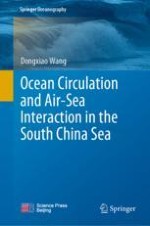This book summarizes achievements of the study on circulation and air–sea interaction and development of the ocean observation network in the South China Sea in the last 20 years, thus serving as a comprehensive reference book to understand the dynamic environment in the SCS. It consists of seven chapters, briefly reviewing our understanding of the SCS circulation and air–sea interaction in chapter 1, then describing in detail the upper layer circulation from large scale (SCS through flow, SCS western boundary current, etc.), to meso- and submeso-scale in Chapters 2 and 5, dilute river plume and coastal upwelling over the shelf in Chapter 3, deep ocean circulation in Chapter 4, tropical cyclone activities and air–sea flux at the interface in Chapter 6, and the construction of the observation network and database in Chapter 7. Besides the basic features of these physical processes, the book also discusses their variations and fundamental dynamics. Thus, it is written in a way that meets the different information demands from researchers working in various marine related fields.
